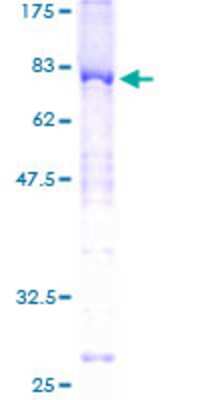Synaptotagmin-1 Products
Synaptotagmins are integral membrane proteins of synaptic vesicles. Synaptotagmin-1 is a glycoprotein containing two C2 domains related to protein kinase C and sites for calcium-dependent binding of acidic phospholipids. Synaptotagmin-1 participates in the process of vesicular trafficking and exocytosis by inducing local calcium-dependent buckling of the plasma membrane. Synaptotagmin-2 is a single-pass, type Ia/III (no signal sequence) transmembrane (TM) glycoprotein. Synaptotagmin-2 is an integral component of neurotransmitter-containing synaptic vesicles that detects action potential-induced increases in presynaptic cytosolic calcium. Increased ionic calcium binds to synaptotagmin II at two sites (C2a and C2b) on its cytoplasmic tail. The first site also binds phospholipid, while the second site binds syntaxin. This promotes vesicle membrane fusion with the presynaptic plasma membrane, resulting in neurotransmitter release.
Synaptotagmins undergo three types of posttranslational modification that may affect function. N-linked glycosylation and/or O-linked glycosylation are likely necessary for recycling (internalization) of vesicle membrane after neurotransmitter release. Fatty acylation/palmitoylation of synaptotagmin may be necessary for proper cycling. Finally, synaptoagmin phosphorylation within the C2a site regulates calcium-binding, while phosphorylation in the C2b site may regulate calcium and syntaxin interaction.
18 results for "Synaptotagmin-1" in Products
18 results for "Synaptotagmin-1" in Products
Synaptotagmin-1 Products
Synaptotagmins are integral membrane proteins of synaptic vesicles. Synaptotagmin-1 is a glycoprotein containing two C2 domains related to protein kinase C and sites for calcium-dependent binding of acidic phospholipids. Synaptotagmin-1 participates in the process of vesicular trafficking and exocytosis by inducing local calcium-dependent buckling of the plasma membrane. Synaptotagmin-2 is a single-pass, type Ia/III (no signal sequence) transmembrane (TM) glycoprotein. Synaptotagmin-2 is an integral component of neurotransmitter-containing synaptic vesicles that detects action potential-induced increases in presynaptic cytosolic calcium. Increased ionic calcium binds to synaptotagmin II at two sites (C2a and C2b) on its cytoplasmic tail. The first site also binds phospholipid, while the second site binds syntaxin. This promotes vesicle membrane fusion with the presynaptic plasma membrane, resulting in neurotransmitter release.
Synaptotagmins undergo three types of posttranslational modification that may affect function. N-linked glycosylation and/or O-linked glycosylation are likely necessary for recycling (internalization) of vesicle membrane after neurotransmitter release. Fatty acylation/palmitoylation of synaptotagmin may be necessary for proper cycling. Finally, synaptoagmin phosphorylation within the C2a site regulates calcium-binding, while phosphorylation in the C2b site may regulate calcium and syntaxin interaction.
| Reactivity: | Rat |
| Details: | Mouse IgG2b Monoclonal Clone #ASV48 |
| Applications: | WB, IHC, IP, ICC, KO |
| Reactivity: | Rat |
| Details: | Mouse IgG2a Monoclonal Clone #ASV30 |
| Applications: | WB, IHC, IP |
| Reactivity: | Human, Mouse, Rat, Bovine, Canine, +3 More |
| Details: | Rabbit IgG Polyclonal |
| Applications: | WB |
| Reactivity: | Rat |
| Details: | Rabbit IgG Polyclonal |
| Applications: | IHC, WB, ICC/IF |
| Reactivity: | Human |
| Details: | Rabbit IgG Polyclonal |
| Applications: | IHC, WB |
Recombinant Monoclonal Antibody
| Reactivity: | Human, Mouse, Rat, Drosophila |
| Details: | Rabbit IgG Monoclonal Clone #HL1654 |
| Applications: | WB, ICC/IF |
| Reactivity: | Human, Mouse, Rat, Bovine, Canine, +3 More |
| Details: | Rabbit IgG Polyclonal |
| Applications: | WB |
Recombinant Monoclonal Antibody
| Reactivity: | Human, Mouse, Rat, Drosophila |
| Details: | Rabbit IgG Monoclonal Clone #HL1626 |
| Applications: | WB, ICC/IF |
| Reactivity: | Human |
| Details: | Rabbit IgG Polyclonal |
| Applications: | IHC, WB |
| Applications: | WB, ELISA, MA, AP |
| Reactivity: | Rat |
| Details: | Rabbit IgG Polyclonal |
| Applications: | IHC, WB, ICC/IF |
| Reactivity: | Mouse, Rat |
| Details: | Rabbit IgG Polyclonal |
| Applications: | WB |
| Applications: | AC |
| Applications: | WB |
| Applications: | WB |
| Applications: | WB |
| Applications: | ELISA |
| Applications: | AC |





![Immunohistochemistry: Synaptotagmin 1 [p Ser309] Antibody [NB300-236] Immunohistochemistry: Synaptotagmin 1 [p Ser309] Antibody [NB300-236]](https://resources.bio-techne.com/images/products/Synaptotagmin-1-[p-Ser309]-Antibody-Immunohistochemistry-NB300-236-img0002.jpg)
![Immunohistochemistry-Paraffin: Synaptotagmin 1 Antibody [NBP2-34215] Immunohistochemistry-Paraffin: Synaptotagmin 1 Antibody [NBP2-34215]](https://resources.bio-techne.com/images/products/Synaptotagmin-1-Antibody-Immunohistochemistry-Paraffin-NBP2-34215-img0018.jpg)
![Western Blot: Synaptotagmin 1 Antibody (HL1654) - Azide and BSA Free [NBP3-25706] - Synaptotagmin 1 Antibody (HL1654) - Azide and BSA Free](https://resources.bio-techne.com/images/products/nbp3-25706_rabbit-synaptotagmin-1-mab-hl1654-azide-and-bsa-free-2120249383145.jpg)

![Western Blot: Synaptotagmin 1 Antibody (HL1626) - Azide and BSA Free [NBP3-25705] - Synaptotagmin 1 Antibody (HL1626) - Azide and BSA Free](https://resources.bio-techne.com/images/products/nbp3-25705_rabbit-synaptotagmin-1-mab-hl1626-azide-and-bsa-free-212024941483.jpg)
![Immunohistochemistry-Paraffin: Synaptotagmin 1 Antibody [NBP1-87362] Immunohistochemistry-Paraffin: Synaptotagmin 1 Antibody [NBP1-87362]](https://resources.bio-techne.com/images/products/Synaptotagmin-1-Antibody-Immunohistochemistry-Paraffin-NBP1-87362-img0007.jpg)

![Immunohistochemistry: Synaptotagmin 1 [p Thr202] Antibody [NB300-235] Immunohistochemistry: Synaptotagmin 1 [p Thr202] Antibody [NB300-235]](https://resources.bio-techne.com/images/products/Synaptotagmin-1-[p-Thr202]-Antibody-Immunohistochemistry-NB300-235-img0002.jpg)
![Western Blot: Synaptotagmin 1 Antibody [NB300-739] Western Blot: Synaptotagmin 1 Antibody [NB300-739]](https://resources.bio-techne.com/images/products/Synaptotagmin-1-Antibody-Western-Blot-NB300-739-img0001.jpg)
![Western Blot: Synaptotagmin 1 Overexpression Lysate [NBP2-07722] Western Blot: Synaptotagmin 1 Overexpression Lysate [NBP2-07722]](https://resources.bio-techne.com/images/products/Synaptotagmin-1-Overexpression-Lysate-Native-Western-Blot-NBP2-07722-img0002.jpg)
![Western Blot: Synaptotagmin 1 Overexpression Lysate [NBP2-09583] Western Blot: Synaptotagmin 1 Overexpression Lysate [NBP2-09583]](https://resources.bio-techne.com/images/products/Synaptotagmin-1-Overexpression-Lysate-Native-Western-Blot-NBP2-09583-img0002.jpg)
![Western Blot: Synaptotagmin 1 Overexpression Lysate [NBP2-09584] Western Blot: Synaptotagmin 1 Overexpression Lysate [NBP2-09584]](https://resources.bio-techne.com/images/products/Synaptotagmin-1-Overexpression-Lysate-Native-Western-Blot-NBP2-09584-img0002.jpg)
![ELISA: Mouse Synaptotagmin 1 ELISA Kit (Colorimetric) [NBP2-80287] - Mouse Synaptotagmin 1 ELISA Kit (Colorimetric)](https://resources.bio-techne.com/images/products/nbp2-80287_mouse-synaptotagmin-1-elisa-kit-colorimetric-132202416175696.jpg)